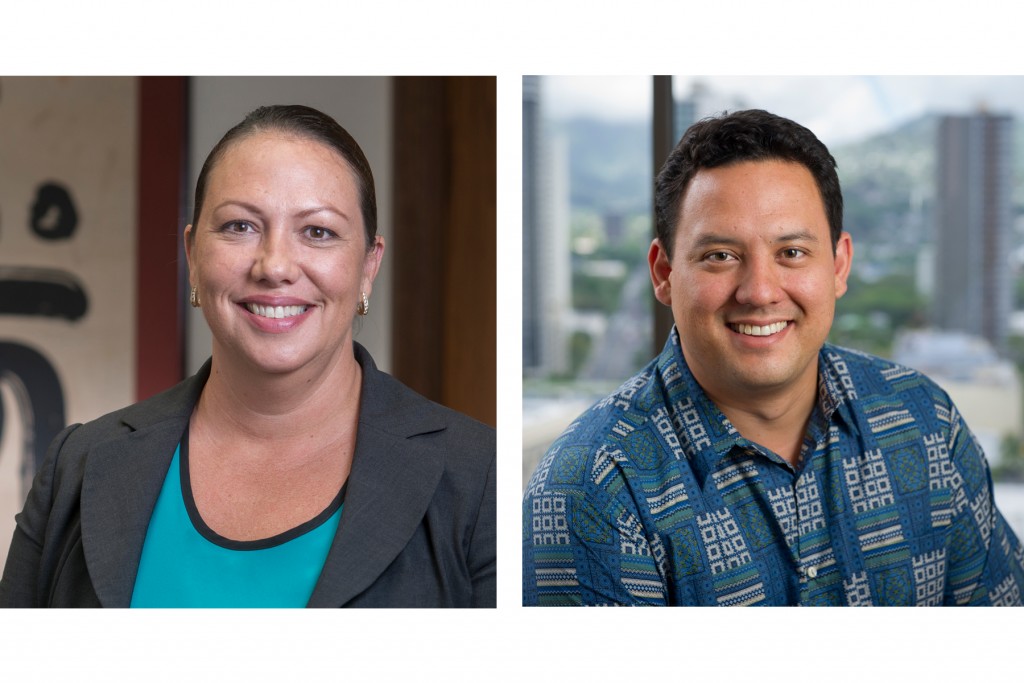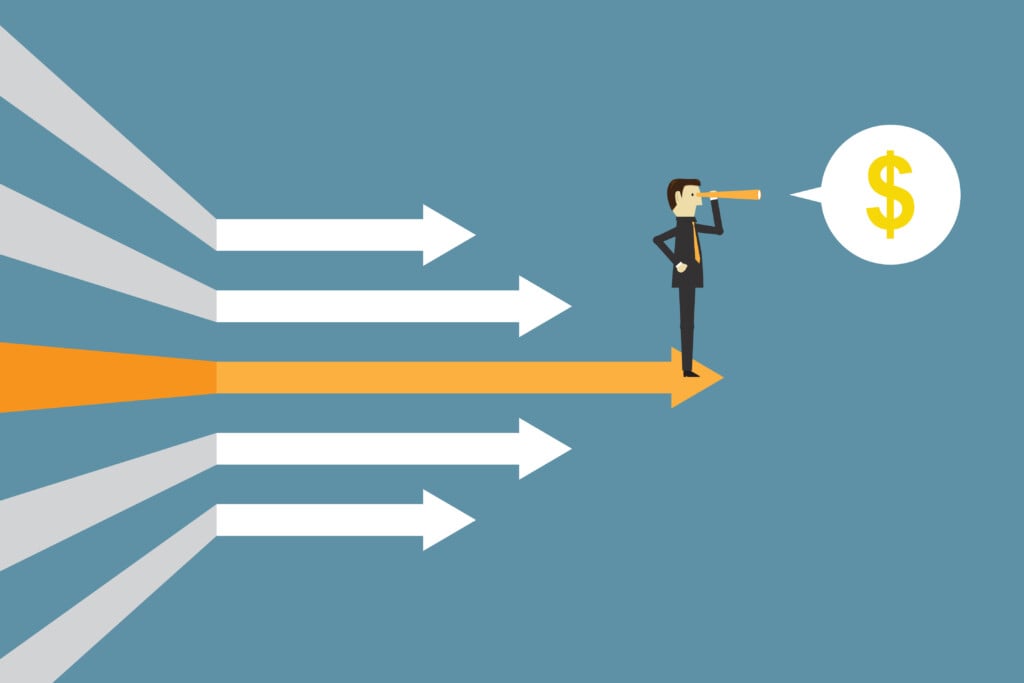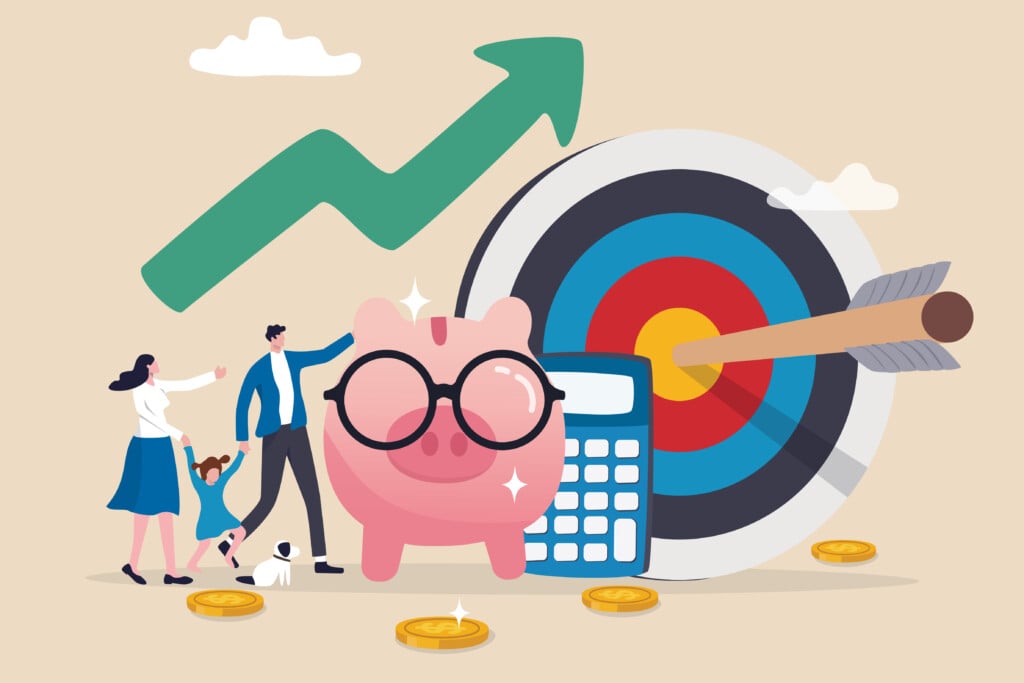Investment Strategies for When You Don’t Know What Lies Ahead

A conversation about investing amid risk, volatility, tariffs, political uncertainty and the unexpected changes that will happen in your own life
Hawaii Business editor Steve Petranik interviews Kaleialoha K. Cadinha-Puaa, CEO, and Neil Rose, president and chief investment officer, of Cadinha & Co., registered investment advisors based in Honolulu. Here is an abbreviated transcript that has been lightly edited.
Steve Petranik: We have been enjoying the longest bull market in U.S. history and a lot of people have done very well in the stock market. But what goes up can come down. What do you think are the chances of a bear market?
Neil Rose: The simple answer is 100 percent. The problem is we don’t know exactly when. It’s not the role of the typical investor to figure out the precise date when things will turn – to get out the way 100 percent. That’s very hard. But they should always conduct themselves with their finances assuming that tough times will come. In our experience, most people come in with either too little in stocks or too much. So these kinds of exercises are good to get people to start thinking about the right proportions and various investment types. That is the value of an advisor, to help sort those things out.
Risk isn’t one thing; risk is many things: The investor’s own personal life, what they need, their objectives, their constraints – and then overlay the macroeconomic side and the opportunities out there.
SP: Does that have a lot to do with the investor’s age?
NR: Age is an input. In our experience, some people overemphasize age. For example, so many people retire at 65. They think: Now I’m a conservative investor and I’ve got to put everything in CDs and bonds and maybe a couple of annuities.
The reality is at 65, most people are technically still very long-term investors and the growing risk for them is outliving their money. So it’s a mistake that people think there’s a formulaic relationship between age and investment strategy and risk allocation.
Kaleialoha Cadinha-Puaa: Age is only one variable. Another variable is income. Being 65 doesn’t necessarily mean you’re retiring. Are you still generating income and earning income from investments? We think it’s really important to look at all of the variables with the best asset allocation for someone regardless of where the markets are. That’s the first step: figuring out what this client can tolerate from risk, then we identify the risks in the market and say, “Steve can’t take this risk. We’re going to bring his allocation down,” or “He can bear more risk and we’re going to keep allocations and try to get a little bit more on the return side.” I think a lot of investors aren’t as wise as they should be if they only look at returns.
SP: What are the other major variables?
KCP: Health. Do you have children? Will your children help you? What will your living arrangements be? It’s lifestyle. We could all retire with a million dollars in cash and depending on our lifestyles we will deplete it at very different rates. And then after lifestyle, it’s your desire about what to do with your money after you’re gone. Those are the main factors.
NR: We’re dealing with high net worth clientele, so in many cases we’re not investing just for their lifetime; it’s a dynastic strategy. They have so much money the chances of it running out in their lifetimes is virtually zero. We’re investing in a much longer time horizon.
KCP: One thing we do know is life changes. You could have a great plan and every box could be checked and then you have a life-changing event. And there’s no plan for that. So that’s another risk that isn’t even associated with market conditions or inflation or any of the economic indicators we watch. Our advice to investors is to be working with someone that’s constantly checking in with them and considering what their changes are. If you have a child or grandchildren, then you have educational expenses, you have college, you have health care.
SP: If people are currently on the aggressive side of the investing spectrum and they want to hedge against a bear market, what should they invest in?
NR: Those feelings are always good justifications to look at your picture. It may not necessitate change based on where they are but it is also pretty common for people who essentially received a windfall when the market has been strong for so many years that it’s a good time for them to maybe rebalance their allocations.
What do they bring their equity allocations down to? Admittedly there still aren’t a lot of good options versus stocks. Some assets are very risky, like high yield bonds. We like good old Treasuries as a place for some return, not a lot, though the rates are rising a little bit. They’re great for counteracting any big drops in the short term in the stock market.
The return on cash at banks is not great but you can get over 2 percent rolling into short term Treasury bills – and not pay state income tax on those. Highest quality, most liquid debt in the world. Available to any investor. Constitutionally guaranteed interest and principal. And every six to 12 weeks, a group of people who make up the Federal Reserve Open Market Committee meet and decide to raise rates 0.25 percent. Maybe in six weeks’ time, we get another 25-basis point increase.
We see different investors. A lot of them are fully invested, maybe too much stock, maybe a lot of stock and every other liquid asset is in bonds and maybe too much in risky credit bonds, because they are reaching for yield, especially because a couple of years ago when there was no yield to be had safely.
Now they are seeing some of those prices starting to crack. People are finding out a bond is not necessarily safe money. A bond is a loan, and it really depends on who you loan to, and yield you get.
KCP: We created a periodic table, a lot like the scientific one, but it’s going back 30 years, of asset class performance. For each year, it lists the performance of international stocks, bonds, cash, value growth, large cap, etc. And the No. 1 performer changes all the time. So, to answer your question, “What do I do if the market goes down?” The answer isn’t always, “Go to bonds.”
But you can see that there are plausible trends. These trends coincide oftentimes with policies. So, again the question is, “What do I do if I feel that the stock market has run?” My deeper answer to that question would be, “Why has it run?” What is the policy that took place, or policies that have taken place, that have caused that to run? What has changed? We feel the tax rate cuts are behind the recent run up in the market. It’s returned a lot of investment income directly back to corporations. We had one of the highest corporate tax rates in the world, and we’ve reduced that. Corporate profits go up without even having to change growth policies. But, something else introduced is tariffs and a possible trade war. Is that enough to offset the gains from the tax market? That’s kind of the question we’ve been trying to “noodle” out and it’s not easy.
There have been times in the past when cash outperformed bonds. Because we’ve come off of Federal Reserve reduced interest rates – in our opinion, artificially reduced rates to stimulate economic growth – that it might be a bad call to get out of equities and go into bonds. It may be a better call to get out of equities and stick with cold cash.
SP: Let’s talk about international equities. Which emerging markets do you find interesting?
KCP: They are all interesting.
SP: Is that how you spend your weekends? (laughter)
NR: We talk about this all the time and we’ve got a lot of different ideas. It’s one of the more fun questions. Sometimes the possibilities are not as useful in the short term, but multiyear in nature. One of the more interesting stories in the world is India. Its economy is not that much bigger than Canada with 35 times as many people. Like a lot of emerging market countries, they’ve had high growth economically, but it almost never correlated to market returns – because a lot of them are missing key ingredients like property rights or are beset by socialism or other isms that are damaging to returns on capital. You need returns on capital to generate higher stock prices. In the last few years under Narenda Modi, India has had some radical changes politically. Somebody who could be sort of the Lee Kuan Yew (the transformational leader of Singapore) of India is focused almost solely right now on little blocking and tackling issues: establishing the rule of law and getting India a bit away from all the bureaucratic red tape and hyper-localism that is very much the Indian economy; privatization of very, very large state-owned enterprises, which allows foreign capital to come in. One of the best demographic stories in the world, I think that half of the population is under the age of 25. That’s usually a good indication of future growth. Now, that growth needs to translate to returns on capital and things like that, but they’ve got a shot. It’s exciting.
What does that mean for the here and now portfolios? Very little. It’s very hard to invest in India. There are some products that supposedly give you Indian exposure, but then you get these companies that may not be actually Indian, and in some cases, you’ve got large multinational outsourcers and tech companies. And you’re not really maybe getting what you expect in the markets there. We can’t just call our local brokerage and get Indian stocks. This is part of the red tape and tradition. To buy real Indian stocks, you have to have an Indian brokerage account. But, before you get an Indian brokerage account, you need an Indian license to open a brokerage account.
When you look at international markets, you have to look at all these markets separately and avoid oversimplifying. Emerging markets has been a multiple asset class, but there is very little these economies share in common. Russia is very different than China, which is very different than India, which is very different that Brazil. Nigeria is now a big country with growth. Where does that lie in the classification? I’m not sure that is an emerging market. Some people classify it as a “frontier market,” and I’m not sure what that means.
SP: Sounds like Vegas.
NR: Yes, but worth looking at. There might not be a great safe way to play those countries now, but discussions, research and knowledge are cumulative. This may serve us five years from now. When there is an opportunity and an opening, we don’t have to start at square one.
SP: Aside from Treasuries, what other investments are you talking about with your clients that may be underappreciated right now?
NR: It seems like everybody’s out there investing or “hunting with shotguns,” as we call it. They are buying big baskets of stocks, they are buying index funds and things like that. There is nothing wrong with that on its face. Although, people “hunting with shotguns” often sell quicker and in bigger magnitude – easy in, easy out with investments. People aren’t investing anymore with conviction. They don’t think through a strategy. “I’m feeling good. I’m feeling bullish. With a click, and virtually no trading cost, I can buy the stock market.” So, index products and ETFs have made bigger traders out of some people, even though they are supposed to be doing the opposite.
One of the more underappreciated investments is old-fashioned hunting for businesses, learning about businesses and investing in businesses. Stocks are not pieces of paper, with prices that fluctuate on a daily basis on a computer or TV screen. They are shares of a real business. And every business is different, every business has different layers or levels of competitive advantage, stickiness, profitability, long term potential, risks even. So, just as everybody has gone to the shotgun method of hunting, we’re hunting with rifles. We’re making sure to do that in this world where competition is only going up and change is happening faster, and business success and business death is happening at a quicker rate. It’s time and labor intensive, and it’s not easy, and there are very long periods of time when it’s a fruitless exercise, (when) you won’t find anything new.
KCP: If you go back to Sarbanes Oxley (federal regulatory law passed in 2002) and changes in regulation coming out of Enron and WorldCom, when you talk about what that regulation did to corporate America and you look at each of the different indices, there are fewer publicly traded companies now. The average investor doesn’t understand that there are fewer choices. And, as regulations have a dramatic effect on these companies, you’ve also had a tremendous move out of publicly traded companies into privately held ones. So, private equity has gobbled up/absorbed a number of different companies. Another example, though it’s not private equity, is how Amazon acquired Whole Foods. Had you been an investor of Whole Foods when that happened, you made money on it. So, it’s looking for really good companies that are desirable to an individual investor, but it’s also looking at individual companies who are positioned well to also be bought at premiums.
SP: You mentioned the trade issues – tariffs and a possible trade war. Does that make you more likely or less likely to go into global securities?
NR: In short, less likely. A trade war doesn’t help anybody overall. But it probably hits foreign and emerging markets disproportionately more. It’s like you have a drinking contest and you go shot for shot with everybody; you might win but you’re still not in a good position afterward. I feel like the U.S. is the one with the strong liver.
SP: Bigger economy.
NR: Bigger economy, more robust, deepest markets. The dollar is global and when people are searching for a life raft, the dollar is going to be a good place to hang on to. But it doesn’t mean that we win. We lose less.
SP: We live in a very politically partisan time. Do some of your clients have trouble separating their feelings about President Trump, whether that’s pro-Trump or anti-Trump, from their feelings about the economy and their feelings about investing?
KCP: I would say more now than it’s ever been. I’ve received more nervous calls from clients – and the market has been in an up trend – just because they don’t like him. In my experience, more than any other time, people aren’t able to separate the economy from their feelings. I tend to have the widows, the single parents as clients. So they are in a demographic that’s different. Neil has a lot more business owners. What would you say?
NR: I think everyone is struggling to define the new political lines. They used to be somewhat clear and somewhat lasting; Left and Right had a definition to it. I noticed that a lot of the Right are trying to figure out who they are. Because, there is not a lot about Trump that is traditional Republican, in terms of platform or philosophy. Republicans were defined in recent decades by supply side economics, free trade, capitalism and fiscal responsibility, things like that. You know, he’s kind of a throwback populist. People are struggling to define him. Luckily, fewer people seem open to talk about politics. So, that’s kind of nice.
KCP: It’s very polarized.
NR: It’s very polarized, but it seems like there is a lot of consensus and sort of exhaustion and nobody really wanting to go there in terms of political conversations. Maybe some things are really relevant, but there is so much that is unanswerable that overdosing on politics is not that fruitful, especially in this environment. There are people out there that have totally cashed out when Trump won, just like a lot of people cashed out when Obama won. And after both elections, the market did the same thing: It went up in a big way. I think that there is something to learn from that.
SP: Is there something else that would be of interest to our readers?
NR: A lot of people’s questions nowadays have to do with cash. Rates have been rising now. We talked about some people (who) have done really well in the markets, but there’s another group that because of the sort of post-traumatic stress of the events 10 years ago, a lot of them still have a lot of cash, and they’ve earned nothing. They’ve mostly cared about safety and hanging on to their capital. They are now keenly aware that the rates are rising and so we get more bank-related questions than anything else. There are ways they can get more interest and not give up safety.
You mentioned at the beginning the length of this bull market. We’re amazed by it too, but bull markets just don’t die. They are usually “assassinated.” One of the things that keeps our equity levels as high as we have is that you don’t see greed in there yet. The greed factor and the envy factor. “So and so is making 25 percent on their money. I’ve got to do that too.” That kind of rationale. You don’t see that yet. A lot of money is still in banks, a lot of money buying stable value funds and stuff like that.
SP: People remember the 2008 recession very clearly?
KCP: They do.
NR: If you think about somebody who is in that spot where you sort of maximize your wealth, around age 55 to 65, and you look what they’ve endured in the last less than 20 years: the dot-com financial crisis, 9/11, 2008, not to mention the mini-bubbles that they happen to participate in, whether it is real estate, the China bubble, the commodity bubble. We’ve had a lot of what we call “rolling bubbles.” All kinds created by ultra-cheap money. Then those things were sort of killed off by raising rates. I’ve seen a lot of people who just give up and they’ve got a disproportionate amount in cash.
With these rising rates, someone will call me. “I’m still scared about the stock market. I might be too late to join in this phase of the bull market. But meanwhile I’m earning nothing, what do I do?” And it’s a good conversation to have.
KCP: We’re still noticing retirement investment complacency and lack of understanding. Your company provides a 401(k). You’re investing in your future and many people don’t really understand what they’re investing in. We’ve seen at least 50 percent of participants going to the default allocation – whatever the default is of their 401(k) plan. I would urge your readers to take a look at their retirement accounts. Go to their HR manager or whoever is involved with 401(k)s and say, “I would like to get access to my retirement account. I don’t even know how much I am in.”
The other thing is, I ask: Do you have leftover money, savings you are putting away in the bank? The one really nifty way to invest in yourself is to try to optimize your retirement account. Especially if your employer is matching. That’s free money. They are doubling your money, and you don’t even have to earn anything. It could be in cash and all of a sudden you have a 100 percent rate of return.
Another issue we didn’t touch upon is volatility – the magnitude of moves in the market on a daily basis are tremendous. Volatility increases because you are not sure where Trump is going, and what’s going on with North Korea or Russia or whatever. You dramatize any of them. When volatility goes up, it’s important for investors to stay nimble and be ready, and not be complacent. Don’t go about your day and forget that you have investable assets. Especially if you are not working with a professional. That’s where people get hurt.
NR: The biggest story now is not so much Trump or any particular thing on the news. The IMF says there is $276 trillion in debt in the world right now. So since the financial crisis of 2008, the world has only compounded debt at a really high rate. The only large group in the world that I think is deleveraged in a meaningful way is the American consumer and the American banks. I think that everybody else – the U.S. government, the local governments and foreign private and public institutions – have only exploded debt, funded by cheap money. We live in a (time) where the world is more coordinated globally and if and when we get a bump in the road …
KCP: When interest rates go up, that’s typically when bumps begin to happen.
NR: It could be central banks overshoot on interest rates, could be the tariff thing, could be some other thing. $276 trillion in debt. If a lot of people are not paying what they have to pay, there will be a domino effect. It’s going to be huge.
SP: The debt is worse than it was in 2008?
KCP: Way worse.
NR: And it’s a lot more global. So for all the mismanagement that we see and feel here in the U.S., the rest of the world has been much, much worse. And on a much bigger scale.
KCP: Our chief strategist Harlan Cadinha’s latest piece was about the leverage. We kind of put ourselves on Sandy Beach and we’re watching the storms coming in from the Moloka‘i/Maui channel, and we don’t know if it is going to go past us, or come right onto the beach. It’s a storm that we are watching. And that’s not even counting what private equity funds are doing. They are leveraging. If all the things properly align, tariffs and you have a bump in interest rates and people aren’t able to service their debt and begin to see defaults or things get really tight, the results will make ’07 and ’08 seem small. It’s not to scare your readers, but this is not a time to be complacent. This is a time to pay attention and to watch.
Because of the uncertainty in politics, we don’t know. We could make scenarios that are really bullish, because there is still tons of cash on the side that investors haven’t been investing. We have some growth policies that come into play, and the markets could double. And we could see markets in half. So, we’re at a point where the leaders of the world have to step very carefully. And that’s the moral of the story.






